Introduction:
The concept of elasticity of demand was first introduced by the classical economists A.A. Cournot and J.S. Mill. Later on, neo-classical economist Alfred Marshall developed it in a scientific way in his book Principles of Economics published in 1890.
Elasticity is a measure of the responsiveness change in the demand of the quantity and its supplied to change in any of its determinants. Like its price, the income of the consumers, prices of complementary or substitute goods, etc. In other words, the ratio of percentage change in the demand of the commodity to change in its determinants. In short, we also say “Elasticity”, an economic tool which measures the behavior of buyers and supplier as per change in its determinants. It allows us to analyze the demand and supply function with full of accuracy.
Following definition can clear your concept about the elasticity of demand:
According to Alfred Marshall
“The elasticity of demand in a market is great or small according to as the amount demanded increases much or little for a given fall in the price and diminishes much or little for a given rise in the price.”
Importance of elasticity of demand
Price elasticity of demand states that price and quantity demanded of the commodity have an inverse relation. When the price for particular commodity increases, its demand decreases and vice-versa. This law says us, how much quantity demanded at a particular price, but this law doesn’t say us the degree of change in demand due to a change in price. In other words, this law doesn’t explain how much demand for commodity increases or decreases due to a decrease or increase in prices. Alfred Marshall developed the concept of elasticity of demand to answer this question.
Types of Elasticity of Demand
Mainly elasticity of demand is categories into three types ie. Elastic, Inelastic and Unitary Demand
Elastic Demand

The change in the quantity demanded by the greater proportion to the change in its price is known as elastic demand. This type of demand is found in a luxury product. Let’s discuss it through an example; suppose the price of the car is $50,000. At this price, the demand is 50 units of cars. When the price of a car decrease to $45,000. Suddenly, its demand is increase to 85 units. This refers to an elastic demand. In other words, we also say that Elastic demand is one when demand for the commodity changed by more percentage than the percentage change in price.
From the above figure, we can see that when the price of the commodity decrease by 10%, its demand increased by 20%. This type of demand for the commodity called elastic demand.
Inelastic Demand
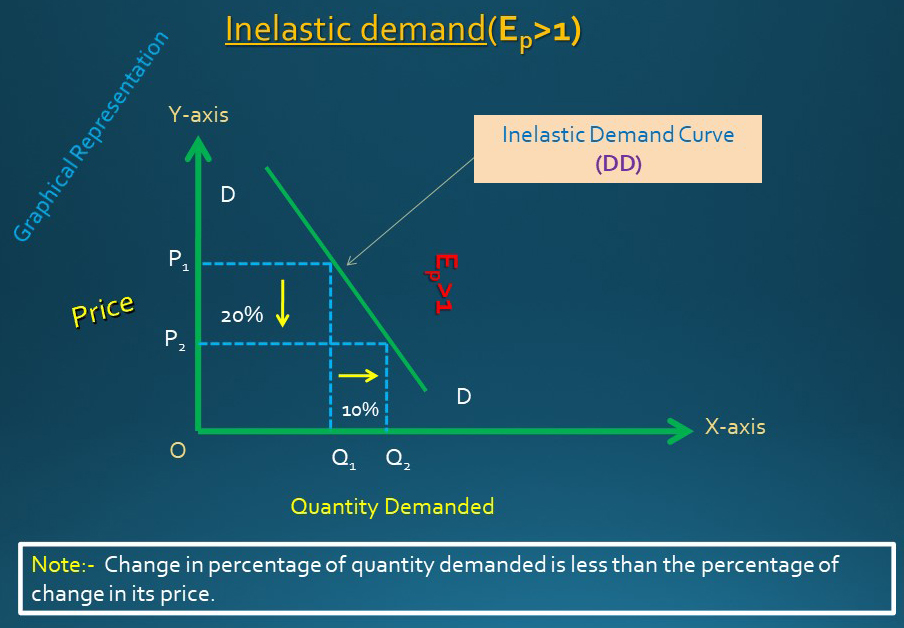
The change in the quantity demanded by the lesser proportion to the change in its price is known as inelastic demand. This type of demand is found in a basic product. Let’s discuss it through an example; suppose demand of the rice is 10 quintal at $1, but when its price decrease to $0.5 its demand increase to 12 quintals. This refers to inelastic demand. In other words, we also say that inelastic demand is one when demand for the commodity changed by less percentage than the percentage change in price.
From the above figure, we can see that when the price of the commodity decrease by 20%, its demand only increased by 10%. This type of demand for the commodity known as inelastic demand.
To know more about elastic and inelastic demand
Unitary elastic Demand
If the percentage change in quantity demanded by the commodity is equal to the percentage change in its price. Demand for the commodity known as unitary elastic demand.
For Example:
If the change in quantity demanded by 20% and change in its price by 20%.
Price elasticity of demand= Percentage change in quantity demanded/Percentage change in price=20%/20%=1
Graphical Representation:
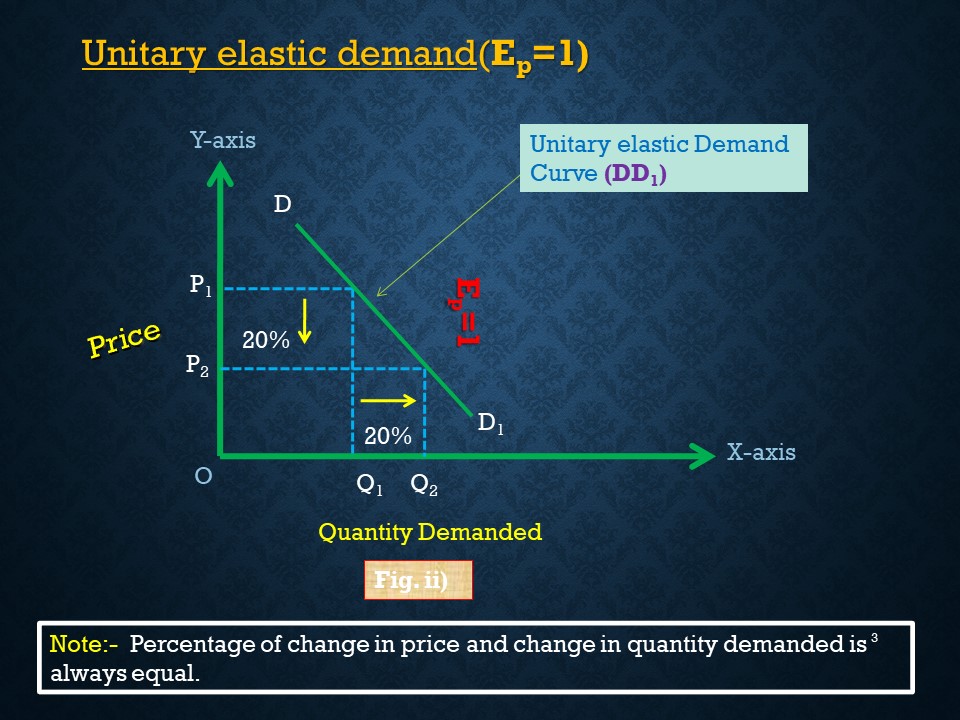
D1D shows the unitary elastic demand curve. From the figure, we can see that when the price is decreased by 20% (i.e. from OP1 to OP2). Its demand also increased by 20% (i.e. from OQ1 to OQ2 ). It shows that when the price is decreased by a certain percentage or number then its quantity demand for that commodities is also increased by the same percentage or number in the case of unitary elastic demand.
Types of Elasticity of demand on the basis of determinants
There are major three types of elasticity of demand on the basis of determinants:
- Price elasticity
- Income elasticity
- Cross elasticity
Price Elasticity of demand
Price elasticity of demand is a measure of how much the quantity demanded of good changes, responds to a change in the price of that good. The price elasticity of demand for any goods measures the change in consumer behavior due to a change in price. Thus, the elasticity reflects the many economic, social, and psychological forces that shape consumer tastes. Demand for a good changed by more percentage than the percentage change in price. These types of demand known as elastic demand. And Demand for a good changed by less percentage than the percentage change in price. These types of demand known as inelastic demand.
Formula for Price Elasticity of Demand:
Economists compute the price elasticity of demand as the percentage change in the quantity demanded divided by the percentage change in price. Mathematically,


Example of computing price elasticity of demand
Problem: Suppose the 10% increase in price of the the commodity leads to 20% decline in the quantity demanded for the commodity.
Price elasticity of demand= percentage change in quantity demanded/percentage change in price
= 20%/10%=2.
Above price elasticity of demand 2 reflect that when the price of the commodity change by a $1 then, the demand for the commodity is changed by 2 units.
Types of Price elasticity of demand
- Perfectly Elastic Demand
- Perfectly inelastic Demand
- Unitary elastic Demand
- Relatively elastic Demand
- Relatively inelastic Demand
Perfectly elastic Demand (Ep=∞)
If a miserable (very very nearly to zero) change in the price of goods leads to an infinitely large change in quantity demanded, it is perfectly elastic demand. In a graphical way, it’s visible as no change in price leads to an infinite change in quantity demanded. It is only a theoretical concept, hardly found in practice or real life.
For Example:
If the quantity demanded increase to ∞ due to no change in price.
Price elasticity of demand= Percentage change in quantity demanded/Percentage change in price=∞/0=∞
Graphical Representation:
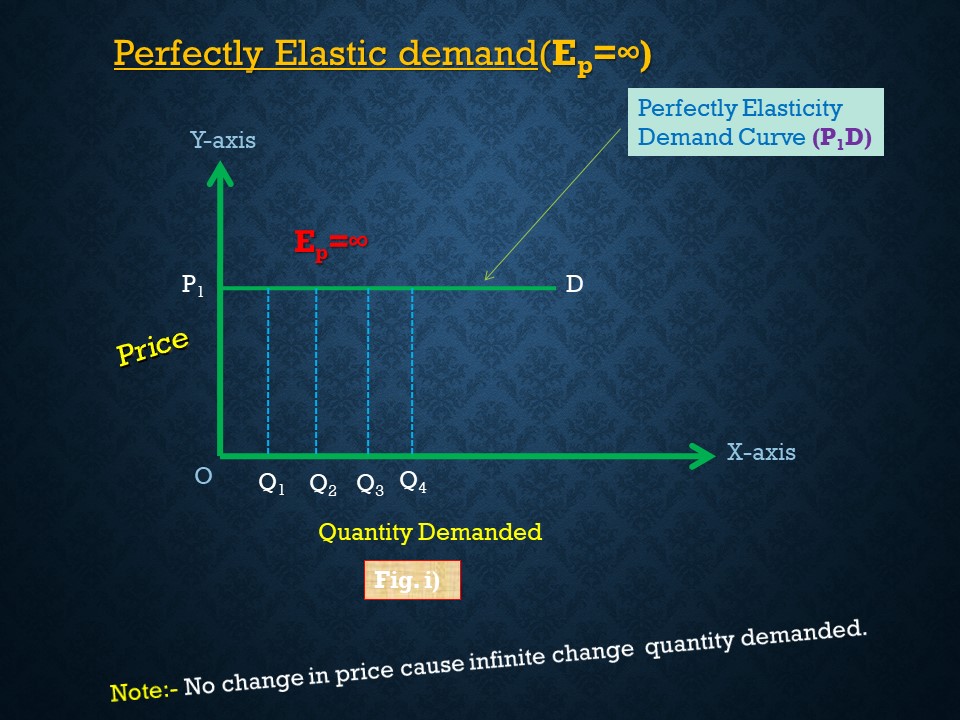

From the fig. i), P1D shows the perfectly elastic demand curve. We can see that when the price remains constant (i.e. OP1). But the quantity demanded is changed i.e. from OQ1 to OQ2, to OQ3, OQ4. It shows that the demand of the quantity is changed if neither changed in the price of the commodity in the case of perfectly elastic demand.
Perfectly inelastic demand (Ep=0)
If the quantity demanded of the commodity does not change with the change in its price. Demand that commodity known as perfectly inelastic. Such types of elasticity are in the case of goods like medicine, salt, etc.
For Example:
If the change in quantity demanded for salt is o due to change in price.
Price elasticity of demand= Percentage change in quantity demanded/Percentage change in price=0/Any amount=0
Graphical Representation:
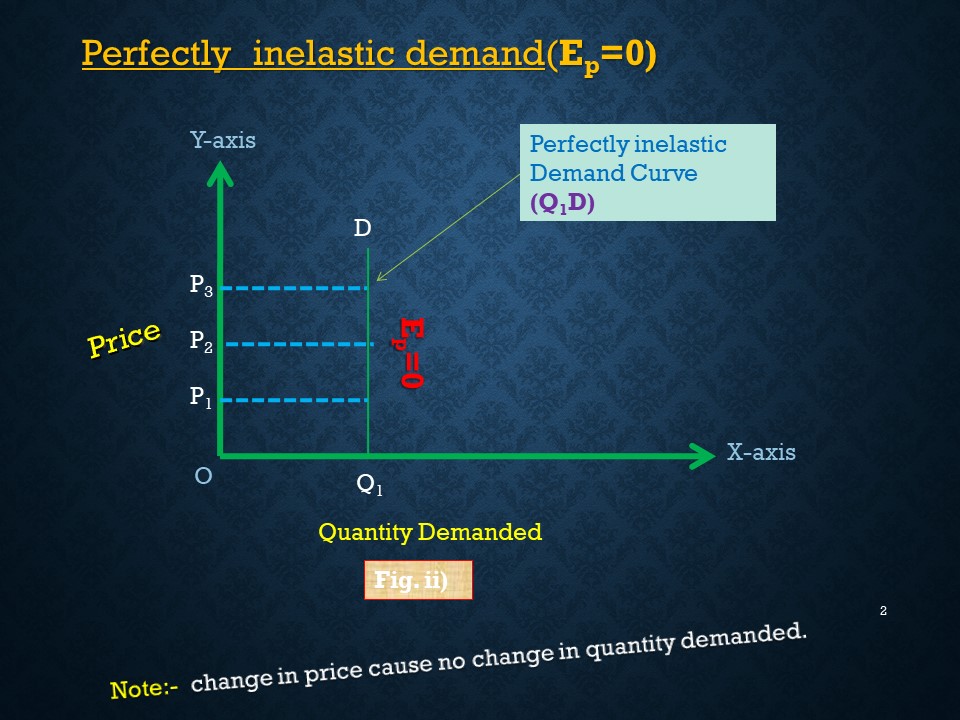

Q1D shows the perfectly inelastic demand curve. From the figure, we can see that quantity demanded to remain the same (i.e. OQ1). But its price changes ( i.e. from OP1 to OP2, OP3). It shows that the demand of the quantity remains unchanged if changed in the price of the commodity in the case of perfectly inelastic demand.
Unitary elastic Demand (Ep=1)
If the percentage change in quantity demanded by the commodity is equal to the percentage change in its price. Demand for the commodity known as unitary elastic demand.
For Example:
If the change in quantity demanded by 20% and change in its price by 20%.
Price elasticity of demand= Percentage change in quantity demanded/Percentage change in price=20%/20%=1
Graphical Representation:



D1D shows the unitary elastic demand curve. From the figure, we can see that when the price is decreased by 20% (i.e. from OP1 to OP2). Its demand also increased by 20% (i.e. from OQ1 to OQ2 ). It shows that when the price is decreased by a certain percentage or number then its quantity demand for that commodities is also increased by the same percentage or number in the case of unitary elastic demand.
Relatively elastic Demand
If the percentage change in the quantity demand for the commodity is more than the percentage change in its price. it known as relatively elastic demand. Such kinds of demand are in the case of luxury goods like cars, jewelers, refrigerators, etc.
For Example:
If the price falls by 10% causes rises in quantity demanded by 20%. Then,
Price elasticity of demand= Percentage change in quantity demanded/Percentage change in price=20%/10%=2
Graphical Representation:
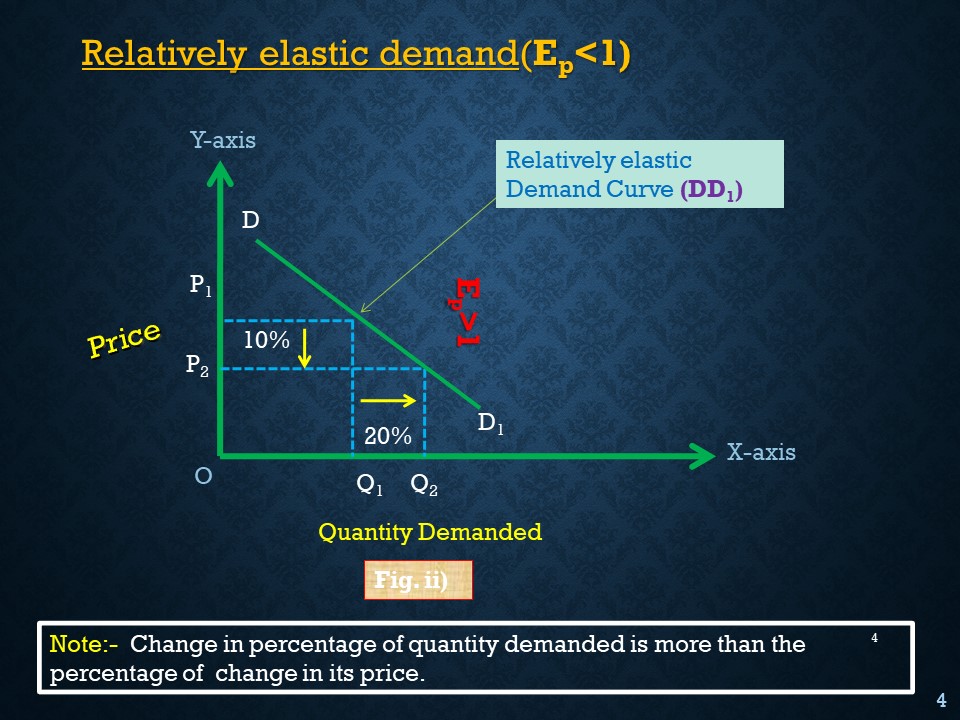

From the fig. iv), D1D shows the relatively elastic demand curve. We can see that when the price is decreased by 10% (i.e. from OP1 to OP2). Its demand is increased by 20% (i.e. from OQ1 to OQ2 ). It shows that when the price is decreased by a certain percentage or number then its quantity demand is increased more than that percentage or number in the case of relatively elastic demand
Relatively inelastic Demand
The percentage change in the quantity demand for the commodity is less than the percentage change in its price. Its called relatively inelastic demand. We can see such types of elasticity in basic goods like rice, vegetables, clothes, etc.
For Example:
If the price falls by 20% causes rises in quantity demanded by 10%. Then,
Price elasticity of demand= Percentage change in quantity demanded/Percentage change in price=10%/20%=0.5
Graphical Representation:
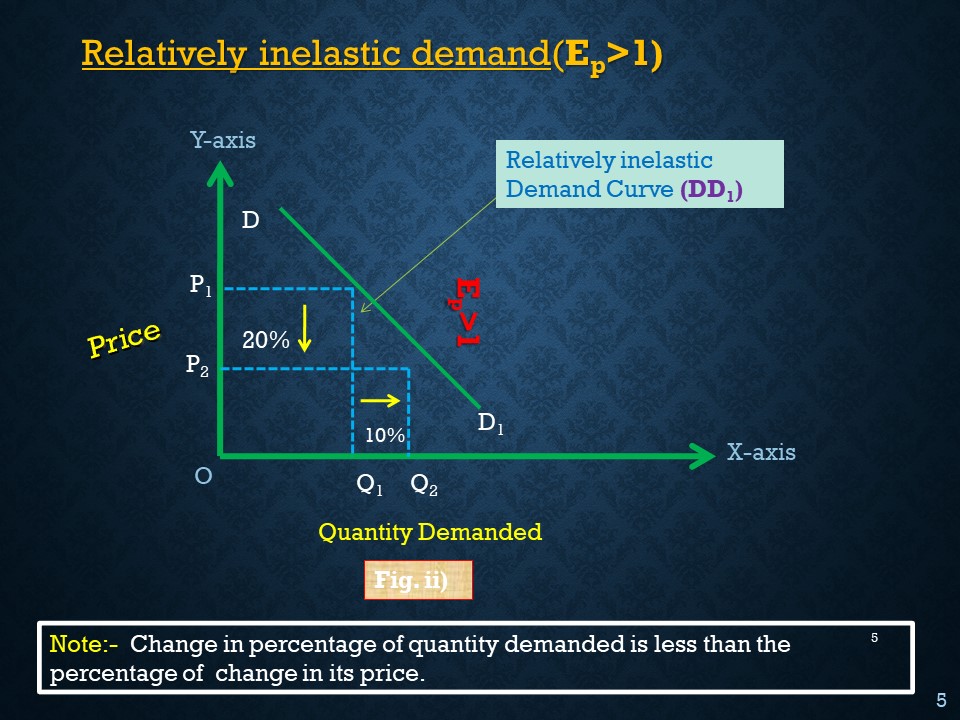

From the figure, D1D shows the relatively inelastic demand curve. We can see that when the price is decreased by 20% (i.e. from OP1 to OP2). Its demand is increased by 10% (i.e. from OQ1 to OQ2 ). It shows that when the price is decreased by a certain percentage or number then its quantity demand is increased less than that percentage or number in the case of relatively inelastic demand
Some Important Questions:
Elastic vs Inelastic of demand
Elastic demand means demand for a good changed by more percentage than the percentage change in price. And Inelastic demand means demand goods changes by less percentage than the percentage change in price.
what is elasticity?
Elasticity is a measure of the responsiveness change in the quantity demanded and quantity supplied to change in any of its determinants. Like its price, the income of the consumers, prices of complementary or substitute goods, etc. In other words, the ratio of percentage change in the demand of the commodity to change in its determinants.
What is meant by price elasticity of demand?
Price elasticity of demand is a measure of how much the quantity demanded of good changes, responds to a change in the price of that good.
Types of Price elasticity of demand
Perfectly Elastic Demand
Perfectly inelastic Demand
Unitary elastic Demand
Relatively elastic Demand
Relatively inelastic Demand
Importance of price elasticity of demand
Price elasticity of demand states that price and quantity demanded of the commodity have an inverse relation. When the price for a particular commodity increase, its demand decreases and vice-versa. This law says us, how much quantity is demanded at a particular price. But this law doesn’t say us the degree of change in demand due to a change in price. In other words, this law doesn’t explain how much demand for a commodity is increased or decreased due to a decrease or increase in prices. Alfred Marshall developed the concept of elasticity of demand to answer this question.
Related Articles:
- Demand – Concept |Demand Function | Law of Demand
- Income elasticity of Demand
- Cross elasticity of demand



